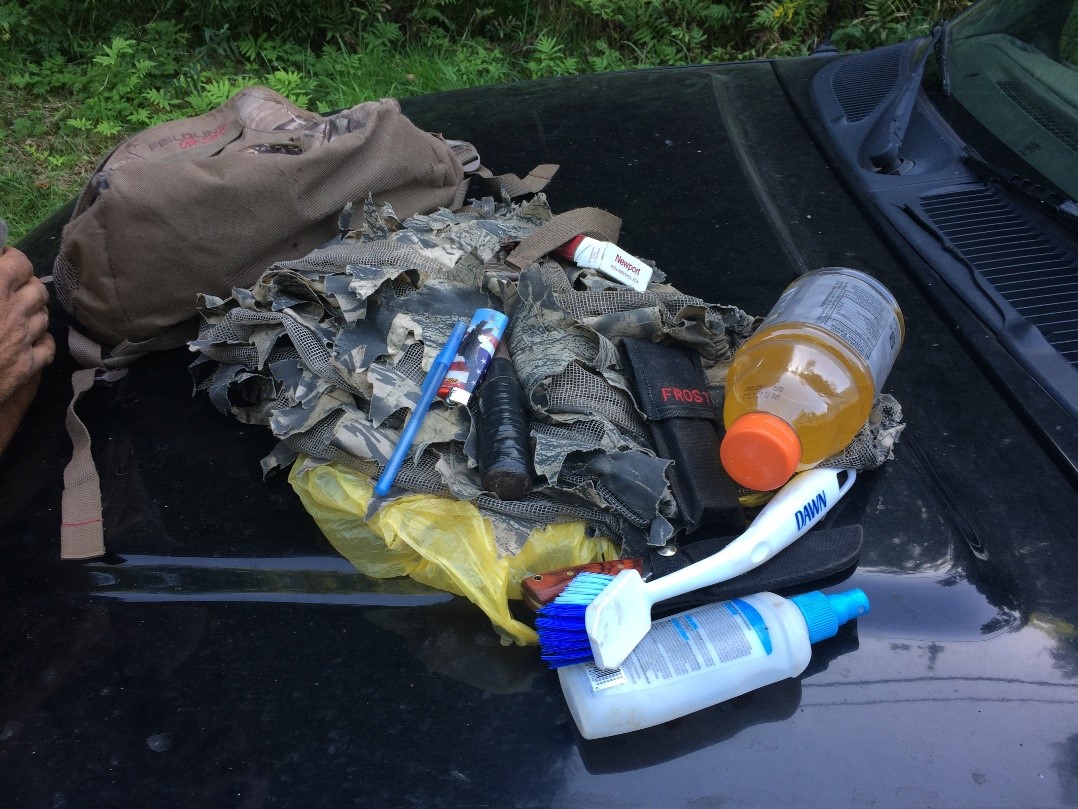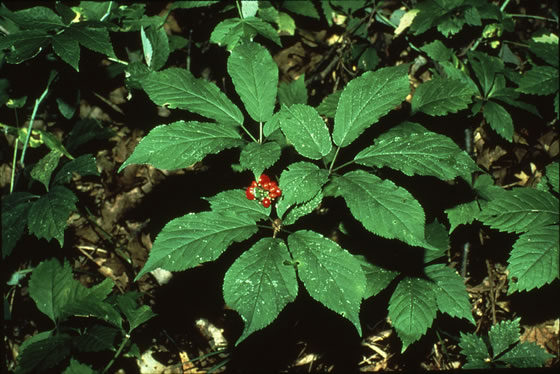
New York conservation offers say Engel’s backpack contained items to dig the ginseng and clean his hands to remove the evidence: Image NY Department of Conservation
By Carin Tunney and Chao Yan
New York conservation officers say 41-year-old Aaron Engel knew what he was doing when he donned camouflage and packed his green camo backpack with a screwdriver for digging and a brush to scrub the grimy evidence from beneath his nails.
They say he drove to a remote state forest in Delaware County, parked along the roadside, climbed a steep bank and trudged through mud and water deep into the woods in search of ginseng. When he found his quarry, he carefully extracted it with his duct-tape covered screwdriver.
Instead of cashing in, when Engel emerged from the woods he found Nathan Doig, a conservation officer with the state Department of Environmental Conservation, waiting in response to a tip.
Engel’s bag contained a half-pound of ginseng roots valued at up to $450.
And despite Engel’s insistence that he was fishing — without a pole — he found himself facing 15 days in jail.
Poaching plants is a crime involving tips, stakeouts and criminals dressed in camo to avoid getting caught by conservation officers. It’s been called the “green gold” and the source of “America’s new gold rush.”
The much sought-after plant is valued worldwide for expansive medicinal claims varying from boosting the immune system, controlling diabetes and fighting cancer, experts say.

American Ginseng plant. Image: US Department of Agriculture Forest Service
Ginseng grows in forests throughout the Midwest, Northeast and parts of Ontario. Poaching it isn’t new, but the crime doesn’t get much attention in the media, environmentalists say.
Poaching involves trespassing and removing plants out of season or on protected or private lands. In New York, ginseng is listed as an “exploitably vulnerable” plant, meaning that its popularity could put its survival at risk. Pennsylvania lists it as “vulnerable” and in Minnesota it is of “special concern.”
Poaching plants is a lucrative crime often motivated by money and drugs.
“It’s basically used as currency,” says Jay Abele, a law enforcement supervisor with the Ohio Department of Natural Resources (DNR).
“What they are doing is getting cash for it. They take that cash, and what we are seeing is a lot of correlation between the ginseng trade related with drugs like heroin and opioids. That money helps them support their habit,” he says.
Thieves sell ill-gotten ginseng to disreputable dealers. Poachers can make between $500 and $1,200 for a pound, says Bob Beyfuss, a retired ginseng expert from Cornell University. It’s highly desired in Asia, where it’s manufactured into supplements, which often ship it back to the U.S. in the form of supplements.

This chart represents trade between Asia and North America in 2013.
Other Midwest plants poached for their medicinal values include bloodroot, yellowroot and goldenseal.
But ginseng is the most lucrative trade by far. Conservation officers say it’s a target of poachers from spring, when the first blooms start to blossom, through the time the autumn forests wither to brown.
The U.S. Forest Service restricts ginseng gathering to prevent its extinction. Ginseng was added to Appendix II of CITES (Convention on International Trade in Endangered Species) in 1975. Appendix II allows trade that is biologically sustainable and legal, and includes species that although currently not threatened with extinction nationwide, may become so without trade controls.
In Michigan, it’s already considered “threatened,” and the state Department of Agriculture and Rural Development says it’s rarely found. In other Midwest states, the plant is more abundant, especially to the south. Wisconsin, Illinois, Indiana, Ohio and New York have ginseng seasons which typically start in September and run as late as December depending on the state.
Those states restrict how much ginseng that can be removed, and often require the replanting of berries. But their laws are tough to enforce because poachers often go unnoticed while committing the crime.

Bloodroot is another Midwest plant that is poached for its medicinal claims. Image: U.S. Forest Service.
Penalties for ginseng poaching depend on whether it’s taken from federal, state or private land. They also vary by state. The harshest penalties are for violations on federal land, and can include a 6-month federal prison sentence and a fine of up to $5,000.
“We have some really good courts and some that don’t understand the impact of what is going on, and they don’t see it as a big deal as far as harvesting before season or stealing from other people,” says Abele of the Ohio DNR. “But we do get some really good finds, and there are people that do get jail time.”
That includes five poachers caught digging more than 250 roots in the Blue Rock State Forest earlier this year, according to the Ohio DNR. The officers received a tip about the crime and set up surveillance on the area, eventually spotting the group returning to a car that pulled in to pick them up. Four men, and a woman driver were sentenced to 25 days in jail, year-long probation, community service and nearly $3,000 in fines.
The crime isn’t taken seriously enough, especially on protected lands, Beyfuss says. “Poaching is often considered a victimless crime — someone went out and dug some wild ginseng that was growing in the state park — that is a slap on the wrist.”
Tomorrow: How investigators use shoe leather and high tech strategies to track plant poachers.
Editor’s note: In Pursuit of Plants is a series of stories about the wild plant trade in the Great Lakes region.
